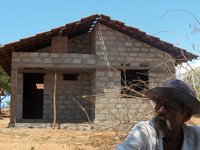
“Are architecture and design really capable of 'solving' global, social and humanitarian crises? Or are such issues too complex to be fixed with simply another lighter, cheaper, emergency tent?” Peter Schmelzer, an architect who interviewed Architecture for Humanity's Cameron Sinclair with me recently, thinks these questions posed in Irene Cheng's
review of
Design Like You Give a Damn marginalize the work of architects. He posts an excellent response to the review and publishes a few new excerpts from our conversation with Sinclair.
Please go read it all, but here are a few salient bits:
Sinclair’s comments suggest that the reviewer’s separationist view of architecture is inaccurate, and that the efforts of Architecture for Humanity do work toward solving social and humanitarian crises. For example, is providing meaningful work to local community members an architectural or design problem? No. But designing for and with the local people, using techniques and technologies that they can build themselves, to resist natural disasters in the future certainly is. And, by intent, it strengthens the local community on social, economic, and aesthetic levels while providing for basic needs.
The reviewer goes on to lambaste AFH for backing away from a project due to limited resources rather than “any qualms about providing a humanitarian palliative to a military action of dubious ethical status.” I chuckle. For any organization, or those suffering from the results of military action, the “Can we do it” question has got to proceed the “Should we do it”. What point is there arguing ethics relative to a project that can’t be realized?
More from the reviewer: “Recent critiques levelled by Slavoj Zizek and others against human rights discourse might equally be applied to humanitarian design enterprises: by framing their task as a neutral matter of ameliorating suffering, they displace politics and a positive collective project of socio-political transformation.”
I can barely believe these words hit the blogosphere, given the politics that led up to the unpreparedness before and the mismanagement after the disaster in the Gulf Coast. We’ve been relying on politics, and they are simply not up to the task. How many disasters must people live and die through before we look for a better paradigm?
More from Cameron Sinclair:
There are two things we adhere to. One is that quiet change matters. So we don’t make a big deal out of it. And also, small projects can have really big impacts. We focus on very low-cost, small projects, not because we want to help one family, but we want to set a base to change policy. So if we can do a project that’s within budget, adheres to current guidelines, but challenges one or two of them—we build the project—then we can go to the government or to the local governing body and say, “Look, if you change your policy, you could affect the lives of millions of people. And here’s a project where we’ve solved your problem.” So we walk into the office with a solution, not a problem.
So, AFH has rescripted the architect from designing emergency shelters into a leader. A leader whose collaborative, technical, and creative skills inform politics and empower communities to improve themselves.
That’s of much more value than an stronger, cheaper emergency tent.
Earlier: Pragmatic Experimentation: An Interview with Cameron Sinclair
 “Are architecture and design really capable of 'solving' global, social and humanitarian crises? Or are such issues too complex to be fixed with simply another lighter, cheaper, emergency tent?” Peter Schmelzer, an architect who interviewed Architecture for Humanity's Cameron Sinclair with me recently, thinks these questions posed in Irene Cheng's review of Design Like You Give a Damn marginalize the work of architects. He posts an excellent response to the review and publishes a few new excerpts from our conversation with Sinclair. Please go read it all, but here are a few salient bits:
“Are architecture and design really capable of 'solving' global, social and humanitarian crises? Or are such issues too complex to be fixed with simply another lighter, cheaper, emergency tent?” Peter Schmelzer, an architect who interviewed Architecture for Humanity's Cameron Sinclair with me recently, thinks these questions posed in Irene Cheng's review of Design Like You Give a Damn marginalize the work of architects. He posts an excellent response to the review and publishes a few new excerpts from our conversation with Sinclair. Please go read it all, but here are a few salient bits:
No comments:
Post a Comment